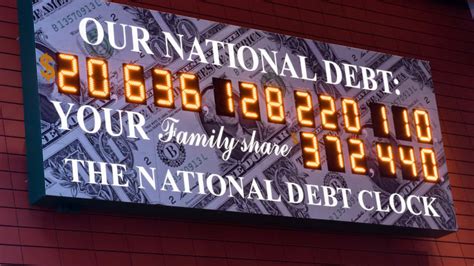
Saturday, April 25
I’ve been wondering about the National Debt Clock. Is it keeping up?
You may have seen the clock. It’s a billboard-size dingus, with spinning, electric-lit numbers. It sits along Sixth Avenue between 42nd and 43rd Streets in Manhattan. Wikipedia says that it first appeared in 1989, and that the idea came from real estate developer Seymour Durst, who worried that future generations would be crippled by the U.S. debt burden. (Yes, you may have heard the name, thanks to a recent, sensational HBO program.)
But I suspect that the true inspiration for the clock came from the professional worriers over the debt.
One of the all-time great worrywarts in this line was President Herbert Hoover, who warned during the Great Depression that “prosperity cannot be restored by raids on the national treasury.” Hoover—and Franklin D. Roosevelt, for that matter—campaigned in 1932 on a platform of balancing the federal budget. (Nearly 24% of the population, or over 12 million people, were unemployed at the time.) As the New Deal, with its deficit financing and many government programs, progressed, Hoover’s warnings became ever more frenzied.
But of course, neither Hoover nor FDR are around today.
As recently as 2008, rich guy and onetime Presidential candidate Ross Perot raised alarms about the debt, saying “not since the Great Depression have we seen an economic crisis of the magnitude that we are facing today.”
And in 2010, a “bipartisan” commission headed by former Republican Senator Alan Simpson and former Democratic Senator Erskine Bowles looked to reduce the federal debt by implementing tax hikes and a number of cuts in federal spending. These included lowering federal spending on health care—hah!—and trimming social security benefits for some recipients. Congress regarded the Simpson-Bowles report with the same enthusiasm it might have shown for mandatory junkets to Chernobyl. Only 11 of the commission’s own 18 members endorsed the recommendations. One who did endorse the commission report: then-Vice-President Joe Biden.
Now, with the federal government throwing money hand-over-fist at pandemic-hammered businesses, health care facilities, and taxpayers, you might think some of these debt-obsessed types would have been agitating to reign in spending. (One organ that is: conservative magazine National Review, which warns that Congress’ massive spending packages “put us farther down the road to fiscal ruin.”) At the moment, though, no one is really paying attention to such voices so far as I can tell.
In any case, you can go to an online version of the National Debt Clock at https://usdebtclock.org
There, you will see the numbers spinning wildly. As of right now, the moment when I am writing this, the clock says the national debt stands at $24,715,691,000,000. Check back in 30 seconds for a much-inflated update. Most ominously of all, the clock has a second figure: Your family’s share of this debt!!!
Expect a bill in the mail any day now!!!
The national debt, it should be said, is just an estimate of how much the federal government is owing to government bondholders and to itself, including to such accounts as the Social Security Trust Fund. And it has seldom been cheaper for the government to borrow money. The wisdom of spending our way back to economic health has seldom been more evident. Yes—throw money at all of our problems! Please!
Today’s dinner: Yay, more leftovers—chicken paprikash and noodles, green salad, and potatoes maybe.
Entertainment: Two episodes of murky Finnish thriller Bordertown and one episode of The Hunters.
